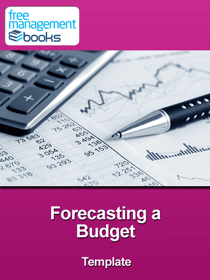
Forecasting a Budget Template
Using the forecasting a budget template provides you with a foolproof method of recording and monitoring your budget and revenue forecasts.
Your ability to forecast with a degree of accuracy depends on how well you have planned your activities, including the breakdown of each activity into cost items. It is essential that you have researched, in as much depth as possible, the likely cost of each item involved in producing each activity or event you have planned.
But, research is not enough on its own you need to know when this spend will occur within the financial year. This demands careful and detailed planning of when each event or activity will be performed and what contribution it will make to the overall budget target. Therefore your annual business unit plan and your forecast spreadsheet will be constantly updated as the former responds to changes in circumstances.
For many managers they will also be responsible for predicting when the revenue will come into the organization. This plays a significant role in the overall performance of an organization and will be a key focus of any board and its shareholders. It is imperative that updating revenue forecasts is a regular part of your weekly activity.
Sales and marketing managers will have regular contact with their teams so that they are constantly aware of how well prospects are being turned into paying customers. The forecasting template has a specific spreadsheet designed to record and monitor the information that is essential for tracking sales and marketing.
The revenue forecast template records:
• Name of budget holder & date spreadsheet last updated.
• Required revenue target is clearly shown so that it is easy to assess whether performance is on track or not.
• Name of each prospect and the Individuals responsible for looking after the sale.
• Records the probability of converting this prospect into a paying customer as a percentage.
• Has a free format column to note key facts and offer explanations that relate to the forecast and their comparison to actual revenue generated as the financial year progresses.
• Columns that show the annual and year-to-date totals.
• Twelve columns that record each month’s forecast and compares it to the actual revenue received and shows the percentage variance.
This can easily be amended or added to so that it meets your exact requirements and enables you to forecast with confidence.
The most important part of forecasts is comparing them to what actually happens on a month-by-month basis. It is the actual results attained are what managers will be judged and rewarded by. It will be that individual’s ability to predict through his or her forecasts what revenue will be received that his superiors will be most focused on.
Forecasting is not about simply picking a likely figure our tot the air or just guessing. It is a skill that requires careful thought and analysis and gets the best results when supported by what is fondly referred to as ‘having your finger on the pulse’! In relating this means ensuring that the information and data you use to base you forecast figure on is as up-to-date as possible and as broad based as practical.
Creating a forecast will always have an element of ‘best guess’ attached to it, but its not complete supposition. The figure you decide for a forecast will be based on the ‘best’ information you have at that time. It is likely that you will also use historic data and past experiences to assist in finalizing this figure.
Every forecast should have a level of a probability assigned to it so that a judgment by superiors can be made about how confident they feel of positive outcome. This takes into account the level of risk and any potential threats associated with the forecast.
Finally, a forecast figure will be based on the current market forces that are influencing the prospect’s decision at that time. The farther into the future a forecast looks the higher the level of uncertainty it has attached to it. It is for this reason that forecasts focus on two time frames monthly and quarterly so that such issues can be taken into account as they occur.
It is vital that all financial information is protected by passwords and kept strictly confidential at al times.
